
You Are My Kindred Spirit: How Growing Up Black In 'The Quiet Racism Of Scotland' Shaped The Art And Politics Of Maud Sulter
You are my Kindred Spirit, the new exhibition of Sulter's work at the Tramway in Glasgow, is testament to that commitment, and shows off her striking artistic sensibility.
Artist, poet, photographer, writer Maud Sulter. Maud Sulter Estate/The Tramway
Uncompromising photomontages that collide visions of European civility with African sculpture. Videos of surgery performed on the artist, stitched together with footage from an early Jane Eyre film. Monochrome images of the artist's early life and extended family, captured from old photographs with the impressions of the passage of time preserved in them. And Sulter's own voice echoes throughout, in readings of her groundbreaking poetry.
Looking for something good? Cut through the noise with a carefully curated selection of the latest releases, live events and exhibitions, straight to your inbox every fortnight, on Fridays. Sign up here .
An exhibition has to have presence to fill the cavernous space of the T2 gallery, converted from the old Coplawhill tram shed. The photomontages of Syrcas (1993), where African art and imagery is superimposed on European landscapes and artworks, provide some of that presence. Their stated purpose, alongside the poem Blood Money (remix), is to recentre the history of black Europeans killed in the Holocaust . They are colourful, tactile, iconoclastic pictures which make you consider what we think belongs where, and what doesn't.
Likewise, the installation Plantation (1994) combines prints depicting Sulter's body, marked out for surgery, and a video splicing a graphic recording of that surgery with Robert Stevenson's 1943 film of Jane Eyre. Her experience is to be read in some sense as the racialised and marginalised Caribbean wife of Mr Rochester, Bertha Mason – the novel's“madwoman in the attic”.
Syrcas (1993). Maud Sulter Estate/The Tramway
Sulter never shies away from taking responsibility, offering her own body as a proxy for people denied just historical recompense. Projected onto the centre of the south wall, her beautiful photographic self-portraits show both her presence and her absence, alternating between observing and turning away from the whole display.
It is important that Sulter's voice forms such a crucial element of the exhibition. Creating oral history through poetic performance emphasises the role of the spoken word in African history , but also the importance of everyday Scottish voices. Individual installations have their own poetic accompaniment, but the soundscape Alba (1995) fills the space with her rich Scottish intonation and Scots words:
Sulter's Alba series depicts love and longing, writing back to William Dunbar's Of Ane Blak-Moir , a poem from the 16th century which suggests the presence of black women in the court of James IV. These sonnets attest to the deep history of blackness in Scotland, and present a black claim to its language and literature.
You are my Kindred Spirit at the Tramway in Glasgow. Keith Hunter / Tramway / Maud Sulter Estate
That deep history is also a contemporary history embodied in Sulter herself, suggested by No Oxbridge Spires (1997). Here, a video camera captures Sulter's family walking through the streets of her Glasgow childhood. She supplies voiceover reminiscences of her young life. Her“present absence” from behind the camera – unseen but heard – is in step with her overall desire to recognise historical absences and to give them voice.
In much of her poetry, Sulter took inspiration, expression and history from pan-Africanism , championing solidarity and the shared experience of people of African descent, and also black cultural politics in England, drawing on figures like the dub poet Linton Kwesi Johnson . Her works celebrated the black body, experimented with Afrofuturist imagery, and drew attention to racial injustice across the world.
As I suggest in my book on blackness in Scottish writing, Sulter was also a vital figure in the Scottish literary landscape. As one of the very first black Scottish writers in the modern era, she contemplated the unexamined whiteness of the imagination of Scotland. She spoke out against the quiet racism of Scottish society, insisting on a black Scotland. That is one reason the cover image is a reproduction of one of her photomontages.
Sulter died from cancer in 2008 at the age of 47. Her impact is felt in poetry, photography, installation art, curation and many other creative areas. She has influenced black arts and literature, feminism and culture in Scotland and beyond. One of her constant preoccupations was the commemoration, or“museumising”, of the past, and how control over that process was open to exploitation.
In bringing together her poetic writing, collage skills, photography and filmmaking, You are my Kindred Spirit models a reclamation of that commemorative process, and develops new relationships with the past – a fitting marker of Sulter's extraordinary legacy.

Legal Disclaimer:
MENAFN provides the
information “as is” without warranty of any kind. We do not accept
any responsibility or liability for the accuracy, content, images,
videos, licenses, completeness, legality, or reliability of the information
contained in this article. If you have any complaints or copyright
issues related to this article, kindly contact the provider above.


















Comments
No comment